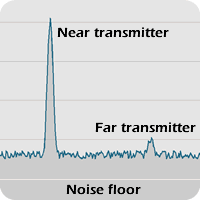
When data radio manufacturers try to tell you that transmit power doesn't matter, it means that their product can't compete. Although important, sensitivity alone can not guarantee range.

Low Noise Floor
Imagine that you're sitting at the dinner table, having a conversation with various guests. If your hearing is good, then you will have no problem understanding what people are saying – even the guests at the far end of the table.
In an ideal world, radio communication would be like this dinner conversation. The more sensitive your hearing, the farther away you could sit, and still not miss anything anyone said.
The license-free ISM band is, by mandate of the FCC, a shared band for license-free devices. So the good news is that you can install ISM-band radio equipment without filing out any paperwork or getting permission from the FCC, but the bad news is that so can everyone else. You have to share the band.

Higher Noise Floor
Now imagine that the dinner table is at a restaurant. Guests at other tables are having conversations of their own, there is music playing, and waiters are singing a birthday song. In RF terms, the noise-floor has raised.
In this new environment, will having more sensitive hearing help you make out the conversations from the far side of the table? Absolutely not! Being able to hear better also means that you can hear all the background noise better too. Even hearing that would make a superhero proud will not help you if there is little difference between what you want to hear and what you want to ignore.
Unless you're installing your data radios in some uninhabited corner of the country, this is the reality you face. RF interference is everywhere.
From our staff scientist:
By their nature, spread spectrum radios are designed to de-correlate the type of interfering signals found on such bands, so that these signals present less interference than conventional radios. This does not mean that spread spectrum radios do not interfere with each other – they do.
In effect, this interference raises the RF noise floor. If these interfering signals raise the noise floor to -103dBm, which is not uncommon, then a receiver will not be able to receive a signal that's below around -100dBm.
In other words, at an average noise floor of -103 dBm, increasing your receiver sensitivity beyond -100 dBm will not result in an increased transmission range. Increased receiver sensitivity simply isn't enough. At this point, the only way to increase radio range is to increase the signal the receiver can see.
What do we have to do in our restaurant analogy? We have to speak louder. That's the only way to cope with our increased noise floor.
There are two ways to increase RF power: either use gain antennas (which can make multi-point systems difficult to install) or increase the transmitter's output power.
This is why Coyote DataCom offers radios from 1 mW all the way up to the maximum allowed ISM-band output level of 1000 mW. Receiver sensitivity is great, but it's no substitute for transmit power.
We have the power to get you the range you need.





